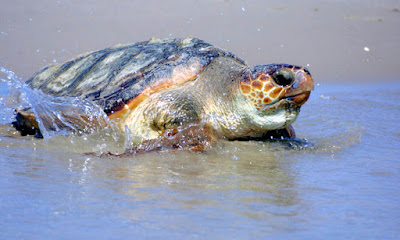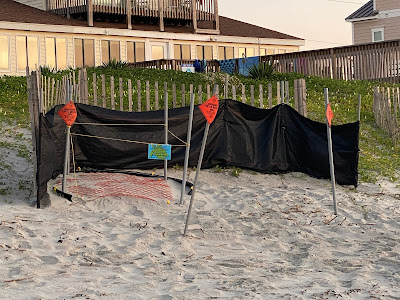Sea Turtle Nesting Season
What an exciting time – Sea Turtle Nesting Season is upon us, Ocean Lakes! These beautiful reptiles will begin making their way ashore to lay their eggs and then a short while after, there will be babies hatching and crawling out to sea. This is a wonderful part of nature, and every now and then we find nests on the beach in front of the campground.
Whether you come across a nest here or elsewhere, we want to take this opportunity to educate you on Sea Turtles and what to do/not to do when that special time comes.
The Scoop on Sea Turtles | Sea turtles are among the largest reptiles in the world and inhabit almost every ocean! Sea turtles are cold-blooded, breathe air, lay eggs, and deposit their eggs on dry, sandy beaches. There are seven species of Sea Turtles in the world. They are the Loggerhead, Kemp's Ridley, Greens, Leatherback, Australian Flatback, Hawksbill, and Olive Ridley.
Did You Know | Fossil evidence proves that Sea Turtles shared the Earth with Dinosaurs over 210 million years ago!
Sea Turtles vs Freshwater Turtles | Sea Turtles differ from Freshwater Turtles because they have flippers instead of clawed feet, cannot retract their heads, and spend all of their life in salt water, except when the ladies come ashore to lay their eggs.
Who is Nesting on the Grand Strand | The Loggerhead, Kemp's Ridley, Greens, and Leatherback Sea Turtles can be found in South Carolina's waters from April through November, or nesting on our beaches from May through October. Loggerheads are the most common Sea Turtle found in our coastal waters and nesting on our beaches.
Did You Know | Leatherbacks travel through our ocean and eat Cannonball Jellyfish on their way south, which is where they do their nesting.
Nesting | Sea Turtle Nesting Season is May 1st through October 31st. They nest every other year but can lay more than one nest in a season.
Sea Turtles come ashore to deposit approximately 120 eggs in a nest cavity in the dry sand dunes. Typically, if a Sea Turtle lays more than one nest in a season, the number of eggs decreases with each nest.
Sixty days after depositing those eggs, the hatchlings emerge during the night and make their way to the ocean. Between the end of July and the end of October is when the nests hatch. When they hatch and begin making their way to the ocean, they follow the moonlight. They use this as their guiding light to lead them to the sea.
Artificial Lights and Disorientation | During the nesting season, the turtles may be disoriented by artificial lights, which are from man-made sources and lead them away from the ocean. Artificial lights include streetlights, gas station hood lights, city sky glow, exterior lights on commercial establishments, high density dwellings, and beach front homes, including pool lights. People on or near the beach carrying flashlights or lanterns, and landscape lighting can also disorient hatchlings and even blind them.
When they are disoriented, they will crawl away from the ocean and waste their energy doing so. They need their stored energy to swim as far as 60 miles once they reach the ocean. They are swimming to locate seaweed, which serves as a form of protection from predators, as well as a spot to find small crustaceans that the hatchlings need to eat to replenish their energy.
It is recommended that during this time of year, all lights visible from the beach or on the beach should be turned off by 10 PM. Windows facing the beach can be shielded with drapes. If lighting is necessary, it should be red versus white.
If a Sea Turtle hatchling is disoriented by artificial light, the maximum federal fine for harming a threatened species is $25,000. Violating local or county lighting ordinances carry fines up to $500. County and local lighting ordinances exist to protect Sea Turtles. Additional fines can be warranted to anyone who harasses, pursues, or tries to capture a hatchling.
Finding a Nest | When we find a Sea Turtle nest on our stretch of beach, we immediately call the South Carolina State Park and wait for their arrival. Due to the amount of traffic on our beach, they have procedures in place to remove the eggs from the nest for their safety. The eggs are relocated to a safer, less trafficked area.
If YOU find a nest on the beach in front of Ocean Lakes, immediately call our Security Team at the Main Gate. The number is (843) 828-4847.
There are volunteer groups, such as South Carolina United Turtle Enthusiasts (SCUTE), that will walk the beach at dawn each morning during the nesting season. If a nest is found and they deem the nest is safe, a Loggerhead Turtle Nest sign is posted, and the area is roped off or covered with fencing to keep it from being trampled or disturbed. Other animals (for example: coyotes and foxes) are on the prowl for Sea Turtle eggs, which is why the fencing is crucial. If they do not deem the nest location safe, then they relocate the eggs.
This group monitors the nests and completes inventories three days after a nest hatches. During these inventories, they are counting the number of total eggs, how many hatched, if any were undeveloped, and assisting the turtles that hatched but were unable to climb out of the nest. This data is reported to SCDNR.
Do NOT Touch | While there are volunteers that are touching these eggs during inventories, this does NOT mean that you should touch them. These volunteers are under the supervision and under permit by the South Carolina Department of Natural Resources (SCDNR).
When Sea Turtles are making their way to the ocean, NEVER pick them up or assist them in getting into the ocean. During their crawl to the ocean, they are imprinting on the beach/sand. When they are old enough to begin laying their own eggs, they will return to the beach they were born on (this is tracked from data recorded by the volunteers and SCDNR). This is a natural and beautiful happening. While it is our instinct to help, we must remember that we need to let nature “do its thing.”
Until Next Time | Sea Turtles are wise animals and have been around for a very long time. They know what they are doing, so we need to trust their instincts, but help them out when we can.
Always remember, this beautiful place that we all call our “Happy Place” is their home, too. Please be respectful and courteous of all living things around us.
















Comments
Post a Comment